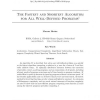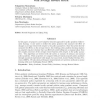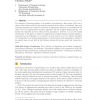1086 search results - page 55 / 218 » Jug measuring: Algorithms and complexity |
CORR
2002
Springer
14 years 6 months ago
2002
Springer
An algorithm M is described that solves any well-defined problem p as quickly as the fastest algorithm computing a solution to p, save for a factor of 5 and loworder additive term...
TCS
1998
14 years 6 months ago
1998
Results on random oracles typically involve showing that a class {X : P(X)} has Lebesgue measure one, i.e., that some property P(X) holds for “almost every X.” A potentially m...
EGH
2009
Springer
14 years 4 months ago
2009
Springer
The GPU leverages SIMD efficiency when shading because it rasterizes a triangle at a time, running the same shader on all of its fragments. Ray tracing sacrifices this shader cohe...
JMLR
2010
14 years 1 months ago
2010
In this paper, we propose a novel adaptive step-size approach for policy gradient reinforcement learning. A new metric is defined for policy gradients that measures the effect of ...
CORR
2010
Springer
14 years 1 months ago
2010
Springer
The diameter k-clustering problem is the problem of partitioning a finite subset of Rd into k subsets called clusters such that the maximum diameter of the clusters is minimized. ...



